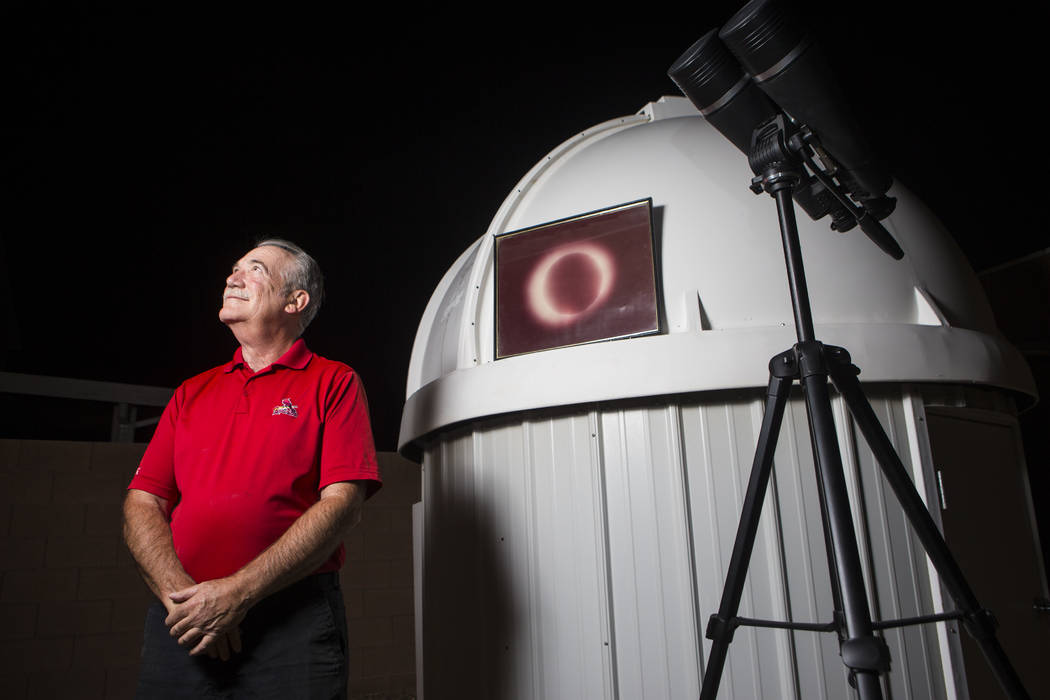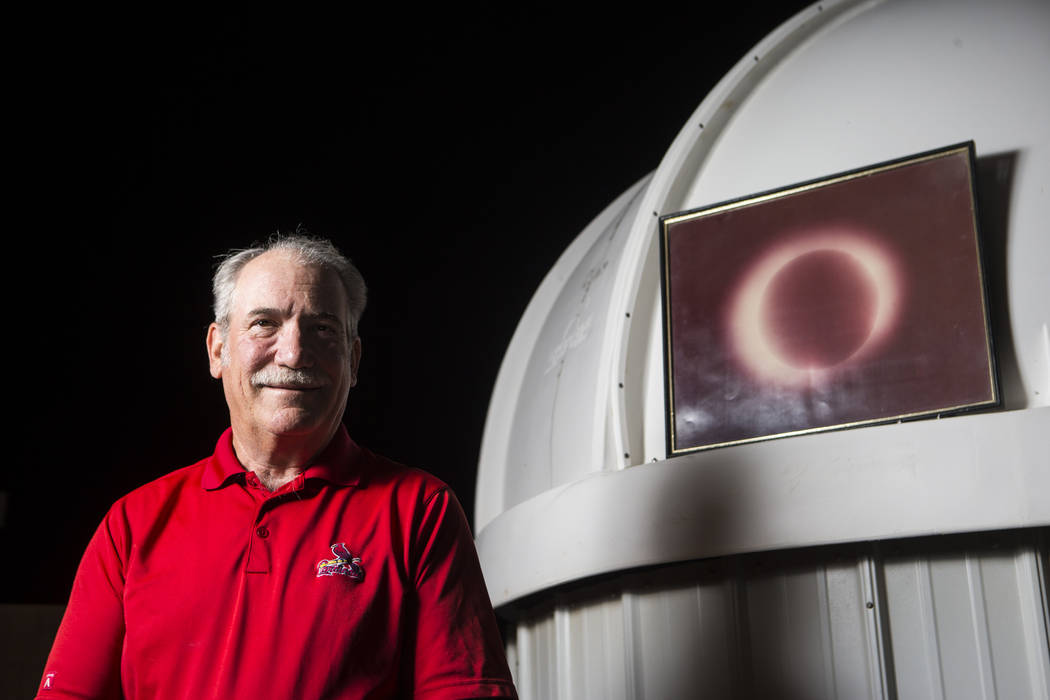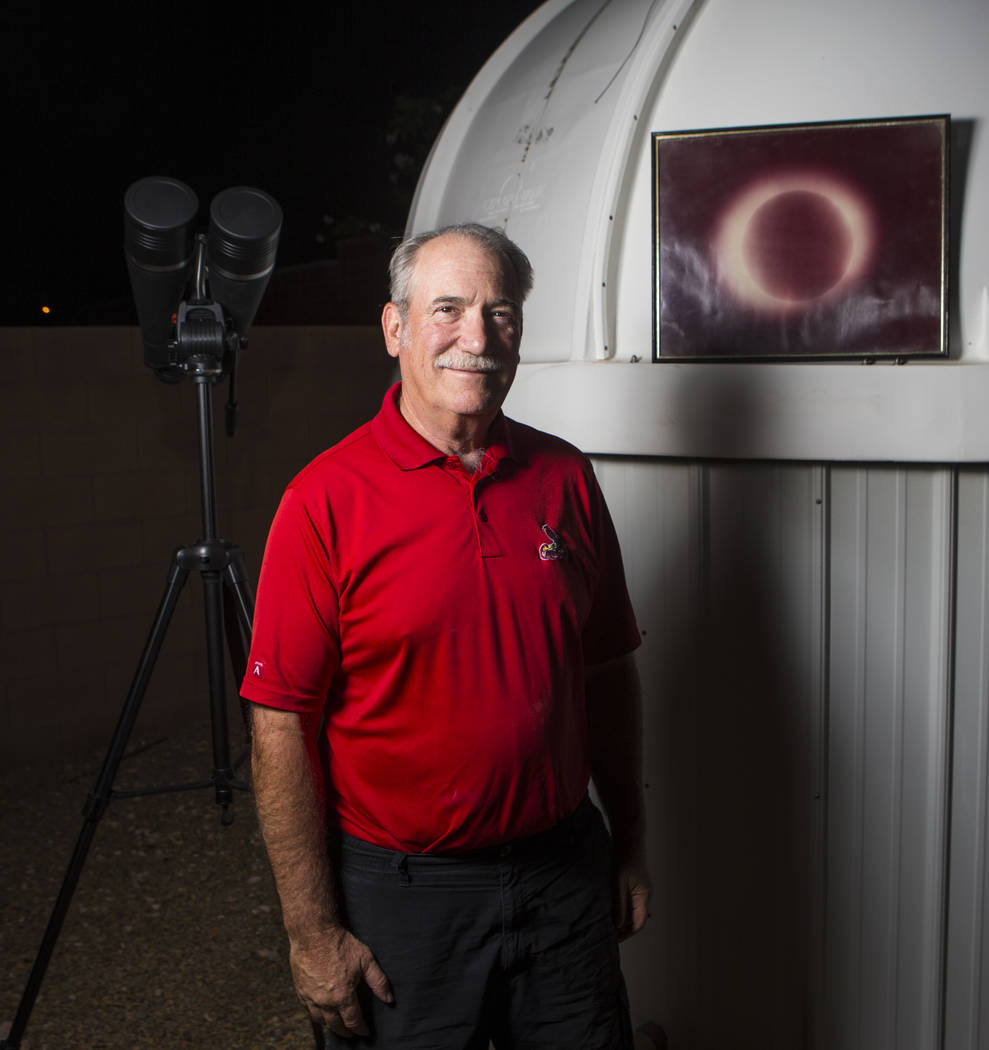Las Vegans follow their passion in chasing the solar eclipse
Jim Gianoulakis knows just where he’ll be when it all goes dark.
The amateur astro-photographer and vice president of the Las Vegas Astronomical Society has staked out a spot in St. Clair, Missouri, about 50 miles southwest of St. Louis, to catch Monday’s total solar eclipse from the very center of the moon’s shadow.
Sure, Gianoulakis could have stayed in Las Vegas, where the so-called “Great American Eclipse” will peak at about 10:27 a.m. with the moon covering about 72 percent of the sun. But there’s nothing quite like the other-worldly experience of momentary darkness in the middle of the day. For the eclipse chaser, there’s simply no substitute for totality.
“The first total eclipse I saw back in 1979 was — and still is — one of the most amazing things I’ve ever seen in my life,” Gianoulakis said.
It was Feb. 26, 1979, the last time a total eclipse was visible in the lower 48, though just barely.
Gianoulakis road tripped to Montana with some friends, then drove around the hills east of Helena looking for an opening in the clouds.
They wound up watching the eclipse from a frozen field that grew even colder as the moon swallowed the sun.
“I remember marveling at the horizon that was outside the shadow being lit up brilliantly even though we were in a very deep dusk,” said Gianoulakis, who was 24 at the time.
What surprised him the most was the sound. The birds stopped chirping. The crickets fell quiet. “Everything just went silent,” he said.
The photo Gianoulakis took that day — his first using a camera attached to a telescope — hangs on the wall of his southwest valley home. “It wouldn’t have made the cover of Time, but it exceeded my expectations,” he said.
This time around, he’s making a family vacation out of it. He and his three adult sons are headed to St. Louis for a three-game series featuring their beloved Cardinals after the eclipse.
“At my advanced age, I can’t afford to miss one,” the 63-year-old joked. “And if it’s cloudy, at least I’ve got some baseball going for me.”
Weather permitting
Here’s the thing about chasing eclipses: “It’s all a crapshoot,” said retired UNLV astronomy professor Diane Smith.
In July 1991, she and her husband, Gene, traveled to Mazatlan, Mexico, for a total eclipse. Monsoon storms completely blocked their view.
In July 2009, they booked a special eclipse tour to China. The clouds were so heavy people in their tour group were doing “anti-rain dances,” Diane said.
In the end, they only got a brief glimpse of the moon and the sun at totality from a highway rest stop outside Shanghai. The experience was unforgettable all the same.
As the sky grew dark behind the clouds, confused bats took wing early and birds flew home to roost, Gene said.
The Smiths will be in Boise, Idaho, on Monday for an astronomy conference that was scheduled around the eclipse.
In the morning, five busloads of conference-goers — the Smiths included — will travel to Weiser, Idaho, on the Oregon border about 75 miles northwest of Boise, to watch the celestial event from a high school football field near the center-line of totality. Hopefully without clouds this time.
A few days before they left for Idaho, Dianne and Gene dropped by the Review-Journal office so she could fact-check the full-page eclipse primer that appears in today’s newspaper. She wore a T-shirt that read “What happens in a black hole stays in a black hole.”
Asked why people are so fascinated by eclipses and willing go to such lengths to experience them, the astronomer shrugged.
“Why do people climb mountains?” she said. “Because they’re there.”
In search of shadows
Lonnie Hammargren is probably Las Vegas’ most famous eclipse chaser, or at least the most eccentric.
The retired neurosurgeon and former Nevada lieutenant governor is so fascinated by the cosmos that he built an astronomical observatory of sorts on top of his museum of a house in the east valley.
Over the past 40 years, he has traveled to Siberia, Australia, Mexico and twice to Africa to see the moon cross paths with the sun.
“The allure is that it’s something that’s so rare, and (to see it) you have to get to a certain place at a certain time,” Hammargren said.
In 2012, Nevada found itself in the path of an annular eclipse — that’s when the moon lines up perfectly with the sun but is too far from Earth to blot out the light completely — so Hammargren ordered 5,000 pairs of dark-filtered glasses with his name on them and gave them away to valley schoolchildren.
For Monday’s big event, the 79-year-old is traveling to a relative’s house on the East Coast so he can catch the Great American Eclipse as it passes through South Carolina and out into the Atlantic.
“It’s fun, it’s happening, and I’m going to go do it,” Hammargren said. “It’s as simple as that.”
Contact Henry Brean at hbrean@reviewjournal.com or 702-383-0350. Follow @RefriedBrean on Twitter.
Partial is better than none
Monday's eclipse will only be total for those within a roughly 70-mile-wide diagonal path across the U.S. from Oregon to South Carolina.
Everyone else in the U.S. — including viewers in Las Vegas — will experience a partial eclipse.
In the sky above Southern Nevada, the moon will begin to move across the face of the sun at around 9:05 a.m. The show will peak here at about 10:27 a.m. with roughly 72 percent of the sun covered. It will all be over by noon.
Here are a few safety tips for viewing or photographing the eclipse:
• Never look directly at the sun without a certified, scratch-free pair of eclipse glasses or a solar viewer. Be sure to have your eye protection on before looking at the sun and remember not to take it off until you look away from the sun. Always supervise children using solar filters.
• If you can't get your hands on eclipse glasses or a solar viewer, you can use pinhole projection to see the moon move across the sun. Stand in the shadow of a leafy tree during the partial eclipse and you'll see the ground dappled with crescent suns projected by the tiny spaces between the leaves. To make your own projection, stand with your back to the sun, hold up a piece of paper with a tiny hole in it or your loosely laced fingers and cast your own crescents on the ground or a nearby wall.
• Don't look at the eclipse through an unfiltered camera, telescope, binoculars, or other optical device. Similarly, do not use your eclipse glasses or hand-held solar viewer to look at the sun through a camera, telescope, binoculars or any other optical device as the concentrated solar rays will damage the filter and enter your eyes.
• Take pictures if you must, but don't get so caught up in your camera equipment that you miss the show. As amateur astro-photographer Jim Gianoulakis put it: "Pay at least as much attention to looking at it as you do to trying to photograph it. It's just something that needs to be experienced."
Safely, of course.
























